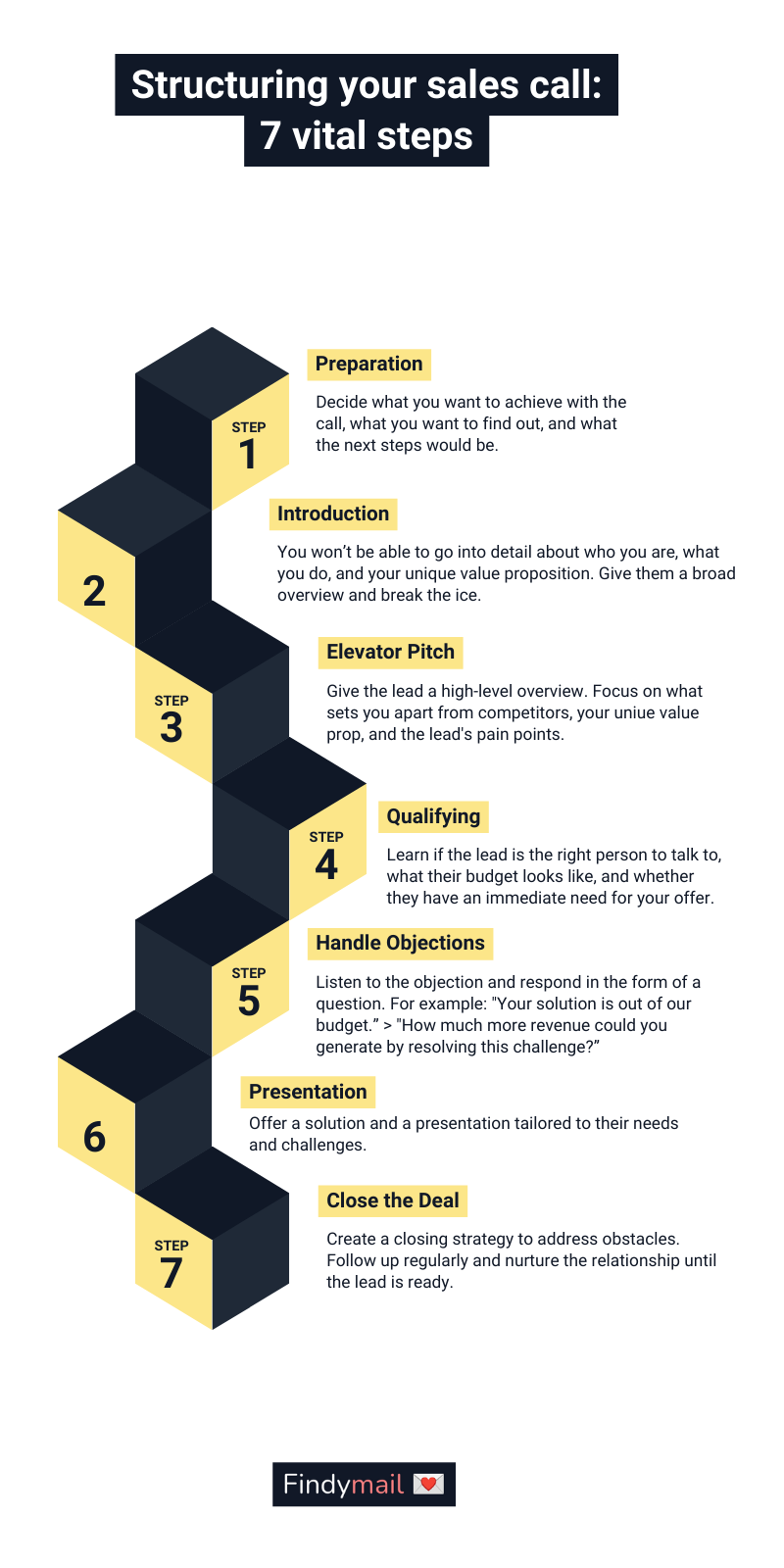No salesperson was born with the ability to sell. Okay - maybe some were. But the rest of us simply follow the battle-tested structure of a sales call.
As soon as you realize that the most successful sales calls follow a specific structure, you’ll discover how easy it is to improve. Suddenly, you’ll have several distinct components that you can analyze separately to find out where your calls fall short.
Your calls will become second nature, and you’ll know what to do next without thinking. You won’t forget essential questions or lose your way as soon as leads raise objections.
So today, we’ll walk you through the ideal structure of a sales call.

Let’s dive in!
The First Step in the Structure of a Sales Call: Preparation
Before you pick up the phone to make a cold or warm sales call, you must prepare properly. Decide:
- What do you want to achieve with the call? (E.g., Warm up the prospect to add them to your sales pipeline, qualify the lead, or go for an instant sale.)
- What do you want to find out during the call? (E.g., The prospect’s challenges or the competitors they’ve used.)
- What are the next steps after the call? (E.g., Creating a proposal, booking a demo, or scheduling a meeting with their team.)
While the answers to these questions will differ based on your circumstances, they’ll, to a large extent, frame how you’ll approach the call.
In addition to this, part of your preparation also involves researching the lead. This means you’ll need to learn more about their company, what they do, the challenges they might have, so you can demonstrate how your offer helps and adds value.
Step 2. Introduction
Once you make the call, you’ll need to start it off on a good note. What you say during the rest of the call won’t matter all that much if you don't. For this reason, you’ll need an effective introduction, especially when you consider that you’ll only have about 15 to 20 seconds to grab your lead’s attention.
You won’t be able to go into detail about who you are, what you do, and your unique value proposition.
What you can do, though, is give them a broad overview of these aspects. This is especially important during cold calls, where the lead can hang up on you anytime. The goal for this type of introduction won’t be to make a sale but to start a conversation.
Step 3. Elevator Pitch
When you’ve broken the ice, and the lead keeps talking to you, it’s time for your elevator pitch.
Give the lead a high-level overview of what you do, what solutions you offer, and what types of customers you help. The more similar your situations, examples, and use cases are to the lead you’re talking to, the higher the success rate.
You can also do other things to improve your closed-won rate in sales calls.
For example, your elevator pitch should:
- Focus on things that set you apart from your competitors. (Pose a high-value sales question inquiring about the solutions your leads have used in the past but didn’t work.)
- Discuss your product’s unique benefits. (Tell the lead how these benefits and features helped solve other companies’ problems.)
- Connect your solution to the lead’s pressing pain point. (If you did your research right, you should understand why this lead needed your product yesterday. Pose the problem statement and show how effortlessly your offer solves it.)
Step 4 in the Structure of an Effective Sales Call: Qualifying
Once you get past your elevator pitch, the lead might have shown interest in your products or services. During the next step, you’ll qualify them further.
To do this, you’ll ask questions to get more information about their business, what problems they’re trying to solve, and how these unsolved problems will impact their business in the future. Here, you’ll also learn what their budget is and when they want to implement a solution.
It’s important to remember that, during the qualifying process, you should listen to the lead’s specific inputs. Not only will this give you deeper insights into the issue they’re trying to solve, but you’ll also show an interest in the lead’s business beyond just making a sale.
Step 5. Handling Objections
Let’s face it, objections are inevitable. So, during your sales call, you’ll likely encounter a few of them, from not having the budget to already implementing a solution. No matter what the objections are, address them effectively.
The first step in doing this is by listening to the entire objection.
Once you understand the objection, you can respond to it. Ideally, do it by responding in the form of a question. This helps you handle the objection effectively by providing a better solution than what the lead currently uses.
For example, if the lead says: “Your solution is out of our budget right now” you could explore further by asking: “How much more revenue could you generate by resolving this challenge?”
Step 6. Presentation
Before the presentation stage, you’ve listened to the lead to identify their problems and addressed objections. Finally, it’s time to bridge the gap and offer a solution based on their needs and expectations.
When doing so, you should prioritize these needs, explain the benefits of your products or services, and prove how these products or services meet these needs. In other words, you should focus on providing value to the lead’s business.
Step 7. Closing
During the final step of the sales call, you can close the deal and sell your product or service to the lead. However, you’ll often find that the lead won’t be ready to decide immediately.
This could be for various reasons, from needing time to consider your solution to needing approval from decision-makers higher up.
No matter the reason, you’ll need a strategy. Typically, this will involve following up with the lead consistently to nurture and convert them. It’s also important to discuss the next steps, so they know what to expect.
Try to end the call with a call-to-action, so the ball is in the lead’s court. For example, ask them about availability for the next meeting or offer to prepare additional materials they can share with their team.
The Bottom Line: You Need to Follow the Structure of a Sales Call (Especially When You’re New)
Even if you’ve been successfully winging sales calls up until now, learn from the sales call structure to improve. Not only is this structure a good roadmap to follow, but it’ll also help you identify key touchpoints in every buyer’s journey.
Once you understand how your audience thinks and purchases, all you’ll need to do is refine your strategy.






